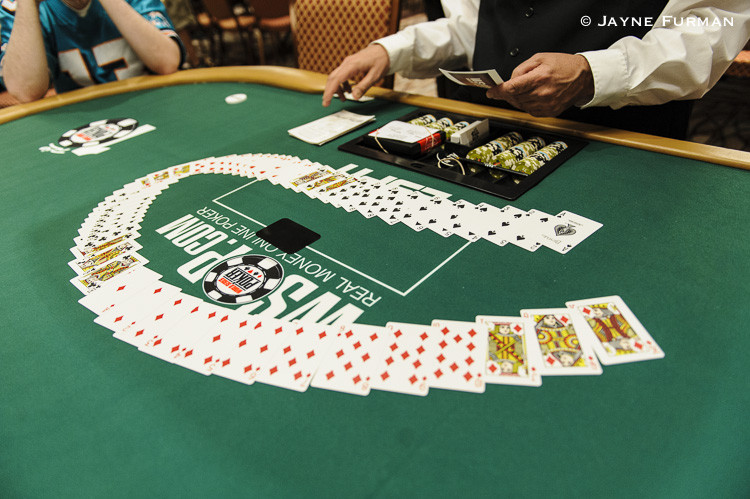Winning Hands Poker Chart
- Use the official poker hands rankings chart and seem them from best to worst! Whether you play live at your local casino or card room. You can almost guarantee that they are winning poker hands.
- By comparing your online poker hands and data to tens of millions of hands from winning online players, Leak Buster looks for over 465+ potential leaks in your game – all in minutes. Read More StackAndTile software will move and organize your poker tables around your screen.
- Poker Range Chart
- Winning Hands In Poker Printable
- Winning Poker Hands In Order Chart
- Winning Hands In Poker Chart
These are standard hand rankings for most poker games and apply to all high-hand poker variations including Texas Hold'em, Omaha and Stud. You'll find a printable poker hand rankings chart below the hand rankings as well as answers to some of the most frequently asked questions about poker hands and poker hand ranking.
NL Hold’em Starting Hand Charts
One aspect of the game of No-Limit Hold’em that causes beginning players much grief is deciding which hands to play and which hands to dump. NL Hold’em is much more difficult than Limit Hold’em because the value of a hand depends on so many factors other than just the cards in your hand. Despite this difficulty, our coaches believe that following some general guidelines and adjusting from these is a better solution than having no guidelines at all. Given that well over half of your profitability in NL Hold’em is based on hand selection alone, we have developed these charts to help you better determine whether to play or fold.
There are no perfect No-Limit starting hand charts. That is because there are many factors that affect your decision, and charts cannot account for all of them. Some of these include:
- The size of your opponent's stacks.
- How loose or tight, passive or aggressive, your opponents are.
- Where these opponents are located at the table – for example, does an aggressive player still have to act after you?
- Your image at the table – for example, how tight or tricky you are perceived.
That being said, these charts will serve you well in most typical low-stakes No-Limit cash games, such as games with blinds of $1/$2, and home games. These games typically have several loose players at the table, and good opportunities for winning big pots with suited connectors and pocket pairs. With practice, you will be able to be a consistently winning player with these charts as a starting point. As you improve, you'll find yourself making adjustments to these charts based on the factors listed above, and more.
AGAIN: These charts are a good starting point for beginners. Specifically, Chart #1 recommends a significant amount of limping. This is great in loose, passive games but less often seen in tougher games. You’ll find other training material on Advanced Poker Training that may recommend a more aggressive approach for more experienced players.
Note: It would be a serious mistake to apply these hand charts before reading the Frequent Asked Questions first.
CHART #1 ‐ LOOSE, PASSIVE GAME (OFTEN 4-5 LIMPERS PER HAND)
NO ONE HAS RAISED YET
- Raise Always
- Call from Early Position, otherwise raise
- Call always
- Call from Middle or Late Position if the conditions are right (see Frequently Asked Questions)
CHART #2 ‐ TIGHTER GAME (FEWER LIMPERS) OR MORE AGGRESSIVE GAME
NO ONE HAS RAISED YET
- Raise Always
- Call from Early Position, otherwise raise
- Call (or Raise) from Middle or Late Position if the conditions are right (see Frequently Asked Questions)
CHART #3 ‐ THERE HAS BEEN A SINGLE RAISE
(3‐5 TIMES THE BIG BLIND) BEFORE YOU

- Re‐Raise Always
- Call from Early Position, otherwise re‐raise
- Call always
- Call from Middle or Late Position if the conditions are right (see Frequently Asked Questions)
FREQUENTLY ASKED QUESTIONS
For the hands in yellow, what do you mean when you say to play these hands if the conditions are right? The hands in yellow are speculative hands. They should always be folded from Early Position. From other positions, they can be profitable given the right conditions. Some of the questions to ask yourself:
- Are there other players who have called so far (the more, the better)?
- Are the players who have called playing poorly after the flop? Will they pay me off if I hit something?
- Is there an aggressive player still to act behind me (you might get raised and have to fold)?
- If there has been a raise and no other callers, what chance do I have of using my position after the flop to win the hand even if I don't improve (Chart #3 only)?
Why does Chart #2 say to sometimes raise with the hands in yellow, but Chart #1 does not? We have different goals in mind. Using Chart #1, we want to call to encourage additional players to enter the pot. These hands will be immensely profitable when our loose, passive opponents enter the hand, and get trapped when we flop a set, or make a well-disguised straight. When using Chart #2, however, we want to size up the opponents still to act. If they are tight, we can raise. Sometimes, we'll pick up the blinds. Other times, our pre-flop aggression will allow us to take down the pot on the flop.
What's the difference between AKs and AKo? AKs means an Ace and King of the same suit. AKo means an Ace and King of different suits.
What are early, middle, and late position? Early Position is generally the first 2 (in a nine player game) or 3 (in a ten player game) positions after the blinds. Late Position is the “cutoff” position (to the right of the dealer), and dealer button positions. Middle Position is everything in between.
How much should I raise? As a general rule, raise 3 to 4 times the big blind, plus 1 extra big blind for every player who has called before you. So if there are 2 callers already, raise between 5 and 6 times the big blind.
What if someone raises after I call? Whether you call the raise depends on how much money the raiser has for you to win, how many other players are involved, and what type of hand you have. As a general rule, if you have a pocket pair, lean towards calling. If there are a lot of other players (and therefore a big pot), lean towards calling. In general, fold suited connectors from early position. Fold hands like KQ that don't play well against a raiser.
How do I play from the blinds? From the small blind, play the same hands you would play from late position, plus a few more. But don't call with junk hands like T5o, just because it is “cheap”. From the big blind, if there is a raise to you, play like you would if you had already called from early position.
The chart says to fold KQo to a raise. Really? Yes, this hand performs very poorly against typical raising hands. Against AK, AQ, AA, KK, QQ, you are a big underdog. Other typical raising hands like JJ, TT, 99, AJs, are slightly ahead of you as well. The only time you might call or re-raise is from late position, if the opener was in middle or late position, indicating they might have a wider range of hands.

I was told to fold AJo from Early Position, why do you say to call with it? Folding AJo is not a bad idea in many games. We included it because, at low stakes tables (even tight or aggressive ones), the players are often playing badly enough after the flop that it can be profitable. We used data from millions of hands of low-limit poker to analyze this. The same could be said for KQo, ATs, and KJs – you can make a small profit in the long run at most low-stakes games, but folding would be perfectly acceptable from early position.
Can I use these charts in a NL Hold'em tournament? The charts would be best applicable to the early stages of a NL tournament, when everyone has a deep stack. In the middle and later stages, they should not be used.
Read all our instructional articles
Knowing your poker hands is crucial to playing a solid game at the table, and regardless of whether you’re playing Texas Hold’em, or Omaha, you’ll always want to know the value of your hand. When you have this knowledge at your disposal, you’ll be able to make an informed decision on whether to raise, check, call, or fold your hand when it matters most.
In this post, we’re going to look at the winning poker hands structure of two different games; Texas Hold’em, and Omaha – and we’ll begin by taking a look at a poker hands chart, followed by the best and worst starting hands. We’ll also show you a list of poker hands to help you make the right decisions in your game.
Texas Hold’em Winning Poker Hands Ranking
In this guide, you’ll see that there are a total of 10 hands in Texas Hold’em poker (or 9 if you don’t count ‘no pair’ as a hand), and we’ll detail these below. (The winning poker hands chart below shows a list of poker hands, ranked best, to worst).
Royal Flush: Ten, Jack, Queen, King, Ace, all of the same suit.
Straight Flush: Any 5 cards of the same suit, in consecutive order. (I.e. 5, 6, 7, 8, and 9 of spades).
4-of-a-kind: 4 cards of the same value (i.e. the 5 of spades, the 5 of hearts, the 5 of clubs, and the 5 of diamonds).
Poker Range Chart
Full House: A full house consists of one 3-of-a-kind hand, and one pair, so for instance, a full house could be the 2 of spades, the 2 of diamonds, the 2 of clubs, and a pair of Aces.
Flush: Five cards of the same suit (i.e. 2, 3, 7, 8, and 9 of hearts).
Straight: Five cards in consecutive order (i.e. 2, 3, 4, 5, 6, off-suit).
3-of-a-kind: Three cards of the same value (I.e. 3 of clubs, 3 or spades, and the 3 of hearts).
Two Pair: Two pairs in one hand – i.e. a pair of 2’s, and a pair of 3’s.
One Pair: One singular pair – i.e. a pair of Aces.
Winning Hands In Poker Printable

Winning Poker Hands In Order Chart
No Pair: A no pair hand is when you don’t have any of the above. In this instance, you have what is known as a ‘high card hard’.
Use the poker hands chart above to ensure you’re always in full control of your game!
Omaha Poker Hands Ranking
Omaha uses the exact same hand-ranking process as Texas Hold’em does, and while it may seem as though that’s a little ‘odd’ at first, remember that Omaha is almost identical, aside from the fact that players have four cards, and that betting is usually pot-limit.
This means that a Royal Flush is the best possible hand in a game of Omaha, and high-card (while incredibly unusual due to the 4 cards each player holds) is the lowest possible hand.
For a full guide on playing Omaha, be sure to check out our How to Play Omaha guide.
Best Starting Poker Hands

Knowing your winning poker hands is crucial if you want to play a solid game of poker – and below, we share how to determine whether or not you have a winner on your hand!
Texas Hold’em: The best starting hand is a pair of Aces. A pair of aces (also known as pocket rockets) are a favourite pre-flop over any other starting hand and is almost always one of the best winning poker hands. The second, and third best starting hands are a pair of Kings and Queens respectively, followed by Ace-King suited, pocket Jacks, pocket Tens, and then Ace-Queen suited. The 10th best starting hand is Ace-King Offsuit – which is actually still a very strong hand.
Omaha: Working out winning poker hands in Omaha is a little more complex than Texas Hold’em, when looking at the best starting hands, although mathematically, the best starting hands can be determined.
For example, the strongest hand is AAKK, followed by AAJT, AAQQ, and AAJJ. It’s worth noting however, that the best possible hand in Omaha holds little value against a full-ring of players, hence the need to play aggressively, pre-flop and post-flop; see our poker hands chart for more details.
Winning Hands In Poker Chart
Worst Poker Starting Hands
Determining the worst starting hands in poker is a little more challenging – largely due to the fact that most players simply have knowledge of the better starting hands – yet knowing what the worst starting hands are is just as important, as it allows you to know when to throw away your hands pre-flop. Below, we look at the worst starting hands for both Texas Hold’em and Omaha.
Texas Hold’em: 2-7 offsuit (this is well-known as the worst starting hand in poker, due to the fact that it’s often used as side-bets in games.) 7-2 offsuit is followed by 8-2 offsuit, 8-3 offsuit, 7-3 offsuit, 6-2 offsuit, 9-2, 9-3, and 9-4 offsuit.
Omaha: Unfortunately, with Omaha, there isn’t an ‘official’ list of worst poker hands – purely due to the fact that there would be too many to list. However, most professionals and poker experts agree that any starting hand that combines any of the worst starting hands in Texas Hold’em generally constitute a very poor starting hand in Omaha too – so it’s worth throwing these away most of the time, pre-flop. If in doubt, consult the list of winning poker hands ranking above.